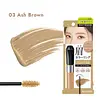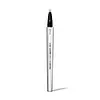What's inside
What's inside
 Key Ingredients
Key Ingredients

 Benefits
Benefits

 Concerns
Concerns

 Ingredients Side-by-side
Ingredients Side-by-side

Water
Skin ConditioningAmmonium Acrylates Copolymer
Propylene Glycol
HumectantAlcohol
AntimicrobialMagnesium Aluminum Silicate
AbsorbentTalc
AbrasiveXanthan Gum
EmulsifyingSilica
AbrasivePhenoxyethanol
PreservativeSodium Dehydroacetate
PreservativeMethylparaben
PreservativeAluminum Hydroxide
EmollientPentasodium Triphosphate
BufferingDisodium EDTA
Panthenol
Skin ConditioningHydrolyzed Silk
HumectantTitanium Dioxide
Cosmetic ColorantMica
Cosmetic ColorantIron Oxides
Water
Skin ConditioningButylene Glycol
HumectantDipropylene Glycol
HumectantAmmonium Styrene/Acrylates Copolymer
Alcohol
AntimicrobialPvp
Emulsion StabilisingTitanium/Titanium Dioxide
Cosmetic ColorantBeheneth-30
CleansingSodium Polyaspartate
HumectantCharcoal Powder
AbrasivePhenoxyethanol
PreservativePentylene Glycol
Skin ConditioningSodium Dehydroacetate
PreservativePolyglyceryl-10 Myristate
Skin ConditioningSodium Metaphosphate
BufferingAmmonium Acrylates Copolymer
Aluminum Hydroxide
EmollientCitric Acid
BufferingXanthan Gum
EmulsifyingDisodium EDTA
Silica
AbrasiveSimethicone
EmollientCI 77491
Cosmetic ColorantCI 77492
Cosmetic ColorantCI 77499
Cosmetic ColorantCI 77891
Cosmetic ColorantWater, Butylene Glycol, Dipropylene Glycol, Ammonium Styrene/Acrylates Copolymer, Alcohol, Pvp, Titanium/Titanium Dioxide, Beheneth-30, Sodium Polyaspartate, Charcoal Powder, Phenoxyethanol, Pentylene Glycol, Sodium Dehydroacetate, Polyglyceryl-10 Myristate, Sodium Metaphosphate, Ammonium Acrylates Copolymer, Aluminum Hydroxide, Citric Acid, Xanthan Gum, Disodium EDTA, Silica, Simethicone, CI 77491, CI 77492, CI 77499, CI 77891
 Reviews
Reviews

Ingredients Explained
These ingredients are found in both products.
Ingredients higher up in an ingredient list are typically present in a larger amount.
Alcohol comes in many different forms. Different types of alcohol will have different effects on skin. This ingredient is usually an astringent alcohol.
These alcohols are drying on the skin. They may strip away your skin's natural oils and even damage your skin barrier. Astringent alcohols may also irritate skin.
Other types of astringent alcohols include:
According to the National Rosacea Society based in the US, you should be mindful of products with these alcohols in the top half of ingredients.
Any type of sanitizing product will have high amounts of alcohol to help kill bacteria and viruses.
Fatty alcohols come from plant oils such as coconut oil. These can help hydrate the skin and are non-irritating. Some fatty alcohols include cetyl and stearyl alcohol.
Learn more about AlcoholAluminum Hydroxide is a form of aluminum. It can be naturally found in nature as the mineral gibbsite. In cosmetics, Aluminum Hydroxide is used as a colorant, pH adjuster, and absorbent.
As a colorant, Aluminum Hydroxide may add opacity, or reduce the transparency. Aluminum hydroxide is contains both basic and acidic properties.
According to manufacturers, this ingredient is an emollient and humectant. This means it helps hydrate the skin.
In medicine, this ingredient is used to help relieve heartburn and help heal ulcers.
There is currently no credible scientific evidence linking aluminum hydroxide in cosmetics to increased cancer risk.
Major health organizations allow the use of aluminum hydroxide in personal care products and have not flagged it as a carcinogenic risk at typical usage levels.
Learn more about Aluminum HydroxideWe don't have a description for Ammonium Acrylates Copolymer yet.
Disodium EDTA plays a role in making products more stable by aiding other preservatives.
It is a chelating agent, meaning it neutralizes metal ions that may be found in a product.
Disodium EDTA is a salt of edetic acid and is found to be safe in cosmetic ingredients.
Learn more about Disodium EDTAPhenoxyethanol is a preservative that has germicide, antimicrobial, and aromatic properties. Studies show that phenoxyethanol can prevent microbial growth. By itself, it has a scent that is similar to that of a rose.
It's often used in formulations along with Caprylyl Glycol to preserve the shelf life of products.
Silica, also known as silicon dioxide, is a naturally occurring mineral. It is used as a fine, spherical, and porous powder in cosmetics.
Though it has exfoliant properties, the function of silica varies depending on the product.
The unique structure of silica enhances the spreadability and adds smoothness, making it a great texture enhancer.
It is also used as an active carrier, emulsifier, and mattifier due to its ability to absorb excess oil.
In some products, tiny microneedles called spicules are made from silica or hydrolyzed sponge. When you rub them in, they lightly polish away dead skin layers and enhance the penetration of active ingredients.
Learn more about SilicaThis ingredient is a preservative with antimicrobial properties. It is the sodium salt of dehydroacetic acid.
It is especially effective at preventing bacterial and fungal growth in low concentrations.
Water. It's the most common cosmetic ingredient of all. You'll usually see it at the top of ingredient lists, meaning that it makes up the largest part of the product.
So why is it so popular? Water most often acts as a solvent - this means that it helps dissolve other ingredients into the formulation.
You'll also recognize water as that liquid we all need to stay alive. If you see this, drink a glass of water. Stay hydrated!
Learn more about WaterXanthan gum is used as a stabilizer and thickener within cosmetic products. It helps give products a sticky, thick feeling - preventing them from being too runny.
On the technical side of things, xanthan gum is a polysaccharide - a combination consisting of multiple sugar molecules bonded together.
Xanthan gum is a pretty common and great ingredient. It is a natural, non-toxic, non-irritating ingredient that is also commonly used in food products.
Learn more about Xanthan Gum